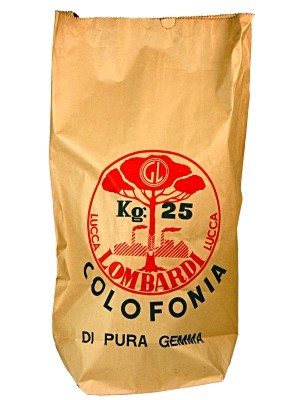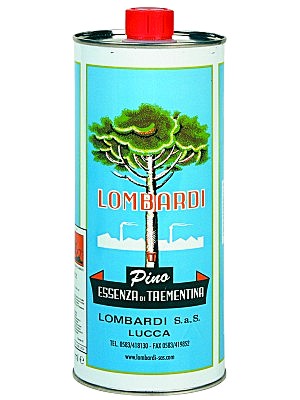Lessico
Colofonia
Pece greca

Pece deriva dal latino pix/picis che significa pece, resina, da ricondurre alla radice indeuropea *pi- = grasso, umore, succo. E in greco la pece è detta píssa.
La pece è un materiale di consistenza più o meno plastica e di colore nero grigiastro, insolubile in acqua e di composizione chimica assai variabile secondo l'origine, che rappresenta il residuo della distillazione o delle frazioni pesanti dei petroli (pece di petrolio) o del catrame di carbon fossile (pece di catrame).
Alla colofonia – o pece di Colofone, antica città dell'Asia Minore, nella
Lidia, tra Smirne ed Efeso – è stato dato anche il nome di pece greca. Si
tratta di una resina di colore giallo-rossastro che si ottiene come residuo
secco della distillazione di alcune varietà di trementina, detta terebinthina
in latino (= resina del terebinto![]() ). La trementina è un prodotto semifluido
che sgorga dalle incisioni praticate nel tronco delle conifere e che all'aria
aumenta progressivamente la sua consistenza fino a trasformarsi in una resina
solida. Per distillazione in corrente di vapore fornisce una frazione liquida
e relativamente volatile, l'essenza di trementina o acquaragia, mentre come
residuo della distillazione si ottiene la colofonia. In Italia, la principale
fonte di trementina è il pino nero o d'Austria, Pinus nigra; in
Francia, la secrezione nota come trementina di Bordeaux è ottenuta dal pino
marittimo, Pinus pinaster.
). La trementina è un prodotto semifluido
che sgorga dalle incisioni praticate nel tronco delle conifere e che all'aria
aumenta progressivamente la sua consistenza fino a trasformarsi in una resina
solida. Per distillazione in corrente di vapore fornisce una frazione liquida
e relativamente volatile, l'essenza di trementina o acquaragia, mentre come
residuo della distillazione si ottiene la colofonia. In Italia, la principale
fonte di trementina è il pino nero o d'Austria, Pinus nigra; in
Francia, la secrezione nota come trementina di Bordeaux è ottenuta dal pino
marittimo, Pinus pinaster.

La trementina è formata essenzialmente da acido abietico, deidro- e diidroabietico. Viene adoperata nell'industria dei colori e delle vernici, nella lucidatura del legno, per la preparazione di adesivi, di materie plastiche, ecc. Trova anche impiego in medicina come emostatico e sotto forma di unguenti o empiastri protettivi di ferite e ulcere.
Rosin, formerly called colophony or Greek pitch (Pix graeca), is a solid form of resin obtained from pines and some other plants, mostly conifers, produced by heating fresh liquid resin to vaporize the volatile liquid terpene components. It is semi-transparent and varies in color from yellow to black. At room temperature rosin is brittle, but it melts at stove-top temperatures. It chiefly consists of different resin acids, especially abietic acid.
Rosin is also known as colophony or colophonia resina from its origin in Colophon, an ancient Ionic city.
Uses
Rosin is an ingredient in printing inks, varnishes, adhesives (glues), soap, paper sizing, soda, and, in past times, sealing wax.. Rosin can be used a glazing agent in medicines and chewing gum. It is denoted by E number E915. A related glycerol ester (E445) can be used as an emulsifier in soft drinks.
In industry, rosin is the precursor to the flux used in soldering. The lead-tin solder commonly used in electronics has about 1% rosin as a flux core helping the molten metal flow and making a better connection. It's frequently seen as the burnt or clear residue around new soldering.
Rosin is also extensively used for its friction-increasing capacity. Such uses include rosining the bows of stringed instruments such as violins, violas, cellos and basses to produce sound. For this purpose, extra substances such as gold and silver are sometimes added to the rosin for extra friction and/or disputable "tone improvements". Ballet dancers sometimes rub their shoes in powdered rosin to reduce slipping before going on stage - it was at one time used in the same way in fencing. Bull riders rub rosin on their rope and glove for additional grip. Baseball pitchers and ten-pin bowlers may have a small bag of powdered rosin nearby, to use on their throwing hand, for better control of the ball. Rock climbers, particularly still in Europe, use Rosin instead of chalk to increase the friction on their hands. The practice has fallen in disfavor in many places, especially the USA, because it is difficult to wash off, and eventually polishes the holds so smooth as to be useless (without more rosin).
A mixture of pitch and rosin is used to make a surface against which glass is polished when making optical components such as lenses.
In pharmaceuticals, rosin forms an ingredient in several plasters and ointments.
Rosin is also added in small quantities to traditional linseed oil/sand gap fillers, used in building work.
When mixed with waxes and oils, rosin is the main ingredient of mystic smoke, a gum which, when rubbed and suddenly stretched, appears to produce puffs of smoke from the finger tips.
Production
Rosin is the resinous constituent of the oleo-resin exuded by various species of pine, known in commerce as crude turpentine. The separation of the oleo-resin into the essential oil-spirit of turpentine and common rosin is effected by distillation in large copper stills. The essential oil is carried off at a temperature of between 100° and 160° C, leaving fluid rosin, which is run off through a tap at the bottom of the still, and purified by passing through straining wadding. Rosin varies in color, according to the age of the tree from which the turpentine is drawn and the degree of heat applied in distillation, from an opaque, almost pitch-black substance through grades of brown and yellow to an almost perfectly transparent colorless glassy mass. The commercial grades are numerous, ranging by letters from A, the darkest, to N, extra pale, superior to which are W, window glass, and WW, water white varieties, the latter having about three times the value of the common qualities.
On a large scale, rosin is treated by destructive distillation for the production of rosin spirit, pinoline and rosin oil. The last enters into the composition of some of the solid lubricating greases, and is also used as an adulterant of other oils.
Properties
Rosin is a brittle and friable, with a faint piny odor; the melting-point varies with different specimens, some being semi-fluid at the temperature of boiling water, while others melt at 100°C to 120°C. It is very flammable, burning with a smoky flame, so care should be taken when melting it. It is soluble in alcohol, ether, benzene and chloroform. Rosin consists mainly of abietic acid, and combines with caustic alkalis to form salts (rosinates or pinates) that are known as rosin soaps. In addition to its extensive use in soap making, rosin is largely employed in making inferior varnishes, sealing-wax and various adhesives. It is also used for preparing shoemakers' wax, as a flux for soldering metals, for pitching lager beer casks, for rosining the bows of musical instruments and numerous minor purposes.
Prolonged exposure to rosin fumes released during soldering can cause occupational asthma (formerly called colophony disease in this context) in sensitive individuals, although it is not known which component of the fumes causes the problem.
The type of rosin used for instruments is determined by the diameter of the strings. Generally this means that the larger the instrument is, the softer the rosin should be, for instance, double bass rosin is generally soft enough to be pliable with slow movements. A cake of bass rosin left in a single position for several months will melt as if it were a liquid, especially in warmer weather.
Sources
The chief region of rosin production is Indonesia, southern China, such as Guangdong, Guangxi, Fujian, Yunnan and Jiangxi, and Northern part of Vietnam. Chinese rosin is obtained mainly from the turpentine of Masson's Pine Pinus massoniana and Slash Pine Pinus elliottii.
The South Atlantic and Eastern Gulf states of the United States is also a chief region of production. American rosin is obtained from the turpentine of Longleaf Pine Pinus palustris and Loblolly Pine Pinus taeda. In Mexico, most of the rosin is derived from live tapping (gum rosin) of several species of pine trees, but mostly Pinus oocarpa, P. leiophylla, P. michoacana and P. montezumae. Most production is concentrated in the west-central state of Michoacán.
The main source of supply in Europe is the French district of Les Landes in the departments of Gironde and Landes, where the Maritime Pine Pinus pinaster is extensively cultivated. In the north of Europe rosin is obtained from the Scots Pine Pinus sylvestris, and throughout European countries local supplies are obtained from other species of pine, with Aleppo Pine Pinus halepensis being particularly important in the Mediterranean region.